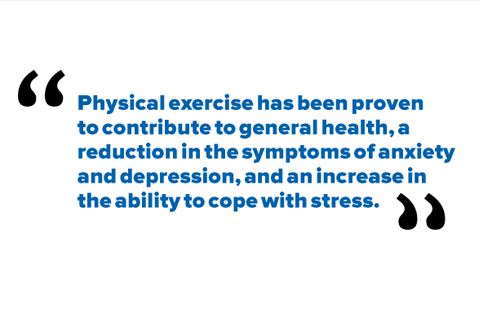Moving for Mental Health

Over the past ten years, millions of Americans have been deployed to Iraq and Afghanistan. Many of these soldiers, Marines, and other veterans are now returning home, and up to 20 percent of them will develop post-traumatic stress disorder (PTSD). Combat-related PTSD is known to cause side effects such as flashbacks or nightmares, avoidance of community or social situations, and an increase in arousal that can cause anger management problems and insomnia. Although the disorder is not new to combat zones—millions of veterans who fought in numerous wars have suffered from PTSD—new research is proving to be useful in helping soldiers reintegrate back into society and fight off the overwhelming effects of the disorder.
For many soldiers, the stigma associated with mental health treatment can be the difference between seeking treatment and fighting the disease on their own. PTSD is the most common psychiatric disorder among combat veterans and, outside of the 700,000 estimated soldiers returning to the United States in the next four years, there are an estimated 400,000 untreated cases throughout the country. Numbers indicate there are a million Americans who suffer from the disorder.
Here’s the good news: Fitness may be a way out of the cycle.
Combat Veterans and Physical Activity
A group of Brazilian scientists conducted a study on the physical activity of patients diagnosed with PTSD. Before being afflicted by the disorder, only a quarter of the patients experienced a lack of motivation to exercise. After a diagnosis of PTSD, the number of those lacking motivation to exercise nearly tripled. Additionally, most of the participants gave up on rigorous physical activity like swimming, jogging, and soccer after experiencing the stresses of PTSD.
The study also found that most of the patients evaluated experienced problems reintegrating into society and feeling a sense of community in their day-to-day environments. Commonly coupled with the symptoms of PTSD were psychiatric disorders such as depression and anxiety issues.
The connection between the symptoms of disassociation and depression could easily be grounded in a lack of physical activity. Physical exercise has been proven to contribute to general health, a reduction in the symptoms of anxiety and depression, and an increase in the ability to cope with stress. Positive side effects like these are invaluable to a PTSD patient and do not require a medication regimen that can have unwanted side effects for veterans weary of the mental health system. A study by Andreas Broocks, a neuropsychopharmacologist, and his associates indicated that for many patients suffering from psychiatric disorders benefitted equally over time from psychotherapeutic medications and physical activity. (Any form of medication regimen should always be discussed with a health professional.) Other psychologists found that improved social support can stem from physical activity.
Fitness for Mental Health
The evidence behind successful exercise-related treatment for psychiatric disorders is strong enough today that most psychologists are suggesting coupling physical activity with normal counseling and medication to increase the chances of recovery. According to Exercise Interventions for Mental Health: A Quantitative and Qualitative Review, psychologists have a few theories as to why the body responds so positively to exercise.
1. Psychological Benefits
Broocks also hypothesized that mood-and-anxiety-altering effects of exercise result in a modification of the serotonin function in your body. Serotonin is a monoamine neurotransmitter and commonly accepted as being linked to feelings of well-being and happiness. Other scientists, such as W.P. Morgan and C.P. Ransford, believe that exercise is connected to the body’s release of beta-endorphins, which can have significant positive emotional effects over a period of time.
2. Sleep Benefits
It is generally accepted that exercising is a handy tool for forcing sleep. Most runners and athletes, as well as those who simply participate in physical activity regularly, report a fairly consistent sleep cycle. This can have emotional benefits because sleep can lead to a better ability to handle stress. Getting some shut-eye can also increase energy, leading to more motivation.
3. Mind Games
K.T. Goode and D.L. Rothe were psychologists who showed that runners who did not focus on running did not fatigue as quickly. The Clinical Psychology: Science and Practice journal article, “Exercise Interventions for Mental Health: A Qualitative and Quantitative Look,” calls this effect “cognitive reaction,” and, when applied in a PTSD setting, means that exercise helps the brain distract itself from thinking about the symptoms the psychiatric disorder causes.
4. Action Tendencies (Breaking the Cycle)
Physical activity is not commonly associated with combat veterans who experience PTSD. In fact, many of them find little to no motivation to participate in physical activity whatsoever. Therefore, a lack of physical activity can be categorized as an “action tendency” of PTSD, as well as of other psychiatric disorders. Exercise is a way for those suffering with PTSD to break the continual cycle of sleep or lack of motivation, which can have a positive effect in disassociating soldiers with their illness and connect them with their physical activity.
How to Get Started
Psychiatric disorders like PTSD are a serious issue and should be discussed with a doctor. There is also no overnight cure for this disorder or other disorders experienced by soldiers returning from war. However, physical activity is a good place to start on the journey to recovery. Studies show there is a fairly equal benefit for both anaerobic activity and aerobic activity. If a veteran likes to run, he should run. If he wants to lift weights, he should lift. Joining a gym can be a way to create that sense of community in a less daunting way, and organizations exist to help veterans get involved in physical activity. PTSD is a serious disorder, but the stigma attached to it is inherently false. Exercise is just one of many options for returning veterans to start on the road toward recovery.






